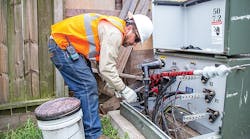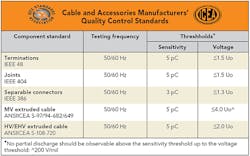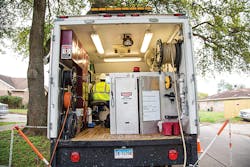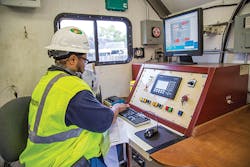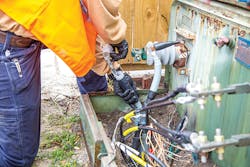It was a huge wave. It was so big it could be seen approaching years in advance. There was a critical question: “What can be done about it?” CenterPoint Energy’s (CNP’s) answer was worthy of a veteran sea captain: Steer directly into the wave and manage it head-on, instead of waiting for the impact. As a result, the utility not only charted a course to address a major concern that had loomed in the near future, but it also developed a proactive, customer-focused approach based on a sustainable system for providing improved reliability, lower operating costs and more efficient asset management.
The utility achieved these benefits through its cable life extension program (CLEP), an innovative process for identifying and addressing the causes of electric interruptions on underground cables and terminations. Since implementing the program in 2013, CNP has seen impressive results not only in improved reliability but also in establishing a way to steadily reduce the backlog of aging underground electric
infrastructure steadily.
Aging URD Loops
The wave CNP faced was the rising number of underground residential distribution (URD) loops that were at least 35 years old. In CNP’s electric service territory — the fast-growing Houston, Texas, U.S., region — the utility now has more than 18,000 URD loops, totaling more than 13,000 miles (20,921 km) of cable and associated distribution equipment. Currently, 27% of the loops have cables at least 35 years old. These loops cause 44% of CNP’s underground distribution system outages, affecting important metrics such as the system average interruption duration index (SAIDI), system average interruption frequency index (SAIFI) and customer average interruption duration index (CAIDI).
Historically, CNP took a reactive squeaky-wheel approach by performing wholesale replacements on an average of 35 loops annually. The decision to replace a loop was based on its age, its reliability performance and whether it was served by large step-down transformers. With more than 5,300 loops currently at least 35 years old, it would take more than 100 years to replace them under CNP’s previous practice. A team within CNP’s Houston electric distribution services began to develop a sustainable solution in January 2013.
Taking a Proactive Approach
In July 2013, the utility implemented CLEP. A key factor in the program’s effectiveness comes from the Factory Grade® cable assessment technology offered exclusively by IMCORP. Until this technology became available, CNP’s assessment of underground cable systems was reactive in nature. Technicians could not identify underground cable failure issues until the cable faulted and customers experienced a service interruption. This practice of run-to-failure also resulted in longer power restoration times.
To give some background, cable and accessory manufacturers test their products to a standard, not guides (IEEE 400 series are guides), thereby eliminating any ambiguity associated with test specification requirements, actual results and certification of a specific quality measure. These factory tests are performed on all new components at the manufacturing plant prior to shipping and installation and must meet Insulated Cable Engineers Association (ICEA) standards for electrical power cable and IEEE standards for separable connectors, joints and terminations.
The manufacturers’ quality-control tests require 50/60-Hz partial-discharge diagnostics at an elevated voltage with better than 5-pC sensitivity (charge signal visibility during testing). Manufacturers are able to test cables and accessories to such high standards because they typically perform their measurements in multimillion-dollar electrically shielded rooms surrounded by steel walls, ceilings and floors to block all electromagnetic interference from radio waves and other high-frequency signals that can hide partial-discharge defect signals that impact product quality.
A new level of complexity is introduced once the cable is installed, then assembled with other cable system components on-site and underground. In the absence of an electrically shielded steel-walled room in the field to test installed cable systems, the only way to achieve a factory-comparable result in the field is to use a factory-grade technology. This requires the use of high-efficiency sensors and advanced digital signal processing to eliminate atmospheric electrical noise and identify the partial-discharge signals that, in some cases, are more than 100 times smaller than the background atmospheric electrical noise.
Just as in the factory, the key to demonstrating the validity of a field test is a documented calibration and sensitivity assessment process performed on each unique cable system being assessed. Data collected on more than 100,000 of these assessments and more than 140 million ft (43 million m) of installed cable systems using the factory-grade technology indicates the key to a reliable foot-by-foot profile is comparability to the factory quality-control standards. This requires specifically applying a 50/60-Hz overvoltage to the cable system for approximately 30 seconds (at peak voltage for less than five seconds) while observing a response with a verified ability to detect and locate 5-pC (five one-trillionths of a Coulomb) signal sources along the cable system.
Typical and Not-So-Typical Challenges
Typical challenges include environmental issues such as system electrical noise, humidity and random atmospheric radio activity. In addition, a number of other factors impacting installation quality are introduced once the products leave the factory: improper handling or damage to components during transport, construction activity that may cut or damage the component insulation, inexperienced craftsmanship and other issues associated with improper installation.
Note that dielectric issues created in cable systems during and after installation cannot be tested in the manufacturers’ shielded room. A field-based factory-grade testing approach enables the utility to gain maximum value by providing actionable information on substandard defects and their precise location, enabling efficient on-site mitigation, repairs or replacement.
With factory-grade technology, IMCORP’s mobile diagnostic units accompany line skill support crews to assess underground cables and terminations within URD loops proactively. By sending an electric charge through each span in a loop at the standard operating voltage and then two higher voltages, technicians can detect any weaknesses and determine which specific part needs to be replaced, rather than rehabilitating the entire loop. The line skill support trucks are outfitted as rolling warehouses, enabling crews to perform mitigation on-site. Following this process, CNP rejuvenated 511 loops in 2014, compared with 36 loops the previous year, before the new program was implemented. This enables the utility to have broader reach at a fraction of the cost.
Early Results
Of the loops assessed thus far, 99.6% have required on-site mitigation or span replacement to return the cables and terminations to manufacturer specifications, or like-new performance condition. However, 72% of the cable spans required little to no action, but because of the level of assessment, IMCORP warranties the assessment for an additional 15 years. The assessment enables CNP to take a surgical approach, enabling technicians to pinpoint specific spans where on-site mitigations are required. On-site mitigations include such procedures as replacement of terminators or elbows, and installation of innovative custom products to extend the life of the cable and prevent service interruptions.
After assessing more than 1,000 loops, averaging 16 cable spans each, and performing more than 15,000 mitigations, CNP has recorded excellent results. The cost to assess and restore a URD loop to like-new performance has been about 65% less than the cost to completely replacement it. Additionally, IMCORP provides a 15-year performance guarantee.
Even at this early stage of CLEP, CNP is experiencing a systemwide improvement in underground reliability. Once mitigations have been performed on a loop, interruptions are reduced by more than 98%, excluding external causes such as lightning, wildlife and dig-ins. Also, with technicians receiving immediate feedback during assessments, most mitigations are performed on-site, improving efficiency and eliminating costly follow up.
Changes and Improvements
In addition to the use of IMCORP’s state-of-the-art technology, this program has led to a number of design standard changes:
•Development of customized product solutions, of which among them is a semiconductor replacement that enables crews to make a factory-grade cutback on the semiconductor while on-site for assessment
•Efficient fleet practices, with mobile diagnostic units outfitted to take the laboratory to the field, and line skill support trucks equipped with components so mitigation can be done during assessment
•Implementing surge protection tailored for 12-kV URD loops and open-tie transformers.
As a result of CLEP, CNP also has realized a number of performance and management improvements:
•Reliability improvements. The utility now has diagnostic capability, receives immediate condition assessment feedback and has the ability to pinpoint system weakness so on-site mitigation can be performed immediately.
•Analytics improvements. The availability of enriched system analytics has led to a predictive model that ranks URD loops and provides asset management capabilities to measure the impact of changes to design and material standards.
•Financial improvements. The utility has been able to make more prudent investments in assets and achieve greater productivity as a result of knowing where specific defects are and having significant year-to-year budget stability. Out of 33 requests from service areas to address problems with loops in 2015, the specific issues were identified and mitigated in 31 instances; only two total loop replacements were required.
Developing a Strategy
Thanks to its innovative approach and the use of leading-edge technology, CLEP has given CNP a strategy for facing the approaching wave of aging underground loops and systematically navigating through and beyond this challenge. With more than 10,400 underground loops currently included in its long-term cable assessment program, the utility projects it will be managing 35-year-old cable and related systems in real time by 2028.
Keith Gray is the service area director for CenterPoint Energy’s Galveston and South Houston service centers. He is responsible for managing the engineering, installation, maintenance and reliability of the electric distribution system for a region that includes 20 cities and 340,000 customers, as well as maintaining relationships with city, county and state officials. Previously, he was the service area manager for the Greenspoint and Humble service centers. He joined CNP in 1982 as a helper in the distribution operations group, progressed through the apprenticeship program and became head line mechanic. He has a degree in business administration from the University of Houston at Clear Lake.
Ernie Kaster is an operations manager for CenterPoint Energy. His primary responsibilities are managing the cable life extension program and facilitating underground rehabilitation work system wide. Kaster has more than 35 years of operations experience at CNP, serving as a line mechanic, supervisor and operations manager in several service areas.
Julienne Sugarek serves as CenterPoint Energy’s director of distribution services. Her responsibilities include overseeing the pole inspection and replacement program, cable life extension program, technology implementation and emergency operations planning. She has served in numerous roles in electric and finance during her nine years with CNP. She has an MBA degree from The University of Texas at Austin and is a licensed certified public accountant.
Editor’s note: This article is based on a project that will receive the Industry Excellence Award for the distribution category at the 2016 Southeastern Electric Exchange meeting.
